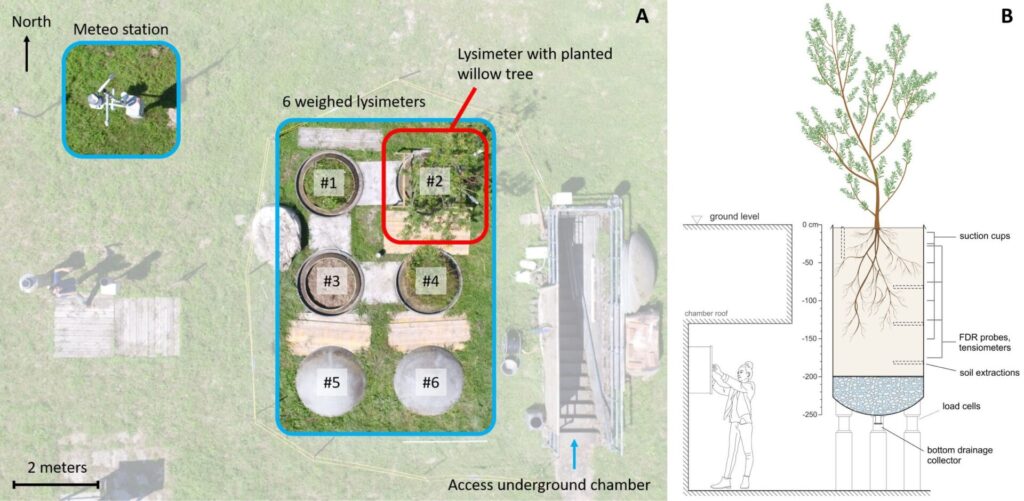The laboratory of ecohydrology at EPFL (ECHO, Prof. Andrea Rinaldo) used to operate 6 large weighed soil columns, termed “lysimeters”, on the EPFL campus. The lysimeters were mainly used to carry out tracer experiments under nonstationary hydrologic conditions.

Each lysimeter is 2.5 m deep and has a surface area of 1 m2. The lysimeters are located into an underground chamber, where they can be access for monitoring and maintenance. They rest on load cells that measure their weight continuously. This allows one to estimate the actual evapotranspiration fluxes accurately.
Main Experiments
The first tracer experiments were carried out between 2012-2015 by Pierre Queloz during his Ph.D. A first tracer application featured 5 Fluorobenzoate (FBA) tracers, which were monitored within the soil column and in the bottom outlet for several months, to provide insight on tracer transport under nonstationary hydrologic conditions. The experimental setup and measurements are documented in Queloz et al. (2015a) and the first model in Queloz et al. (2015b). The tracer breakthrough was strongly bimodal, and this inspired work by Rodriguez, Benettin and Klaus (2020) on multimodal transit time distributions, which received the MG Anderson Award from the journal Hydrologica Processes. A second tracer application featured 2 FBA tracers and water stable isotopes. The comparison between FBA and isotope tracers is described in Benettin et al. (2019).
A second smaller experiment was carried out in 2016, again with 5 FBA tracers but on a shallower version of the lysimeter #1, which was only covered in grass. The experimental data and a transport model are described in Asadollahi et al. (2020).
The third major experiment was carried out in 2018, with the goal of tracing precipitation in the soil but also within the willow tree. This work featured the collaboration with the University of Saskatchewan (Magali Nehemy and Jeff McDonnell). The isotope data analysis are presented in Nehemy et al. (2021), the experimental tracing through the soil and vegetation is discussed in detail in Benettin et al. (2021a) and modeling results are in Asadollahi et al. (2022). Additional papers based on this experiment include Benettin et al. (2021b) and Nehemy et al. (2022).
As of 2023 the lysimeters have not been operational.
Data availability
The hydrologic and Fluorobenzoate data from the first set of experiments are in the Supplement of Queloz et al. (2015a). The isotope data from the same experiment is in the Supplement of Benettin et al. (2019).
The hydrologic and Fluorobenzoate data from the second experiment (shallower soil covered in grass) is available in a Zenodo repository as Asadollahi et al. (2019)
The experimental data from the third experiment (isotope tracers, samples collected in soil, bottom drainage and plant xylem) is available in a Zenodo repository as Nehemy, Benettin et al. (2020).
Literature on the EPFL lysimeters
Asadollahi, M., Nehemy, M. F., McDonnell, J. J., Rinaldo, A., & Benettin, P. (2022). Toward a Closure of Catchment Mass Balance: Insight on the Missing Link From a Vegetated Lysimeter. Water Resources Research, 58(4). https://doi.org/10.1029/2021WR030698
Nehemy, M. F., Benettin, P., Allen, S. T., Steppe, K., Rinaldo, A., Lehmann, M. M., & McDonnell, J. J. (2022). Phloem water isotopically different to xylem water: Potential causes and implications for ecohydrological tracing. Ecohydrology. https://doi.org/10.1002/eco.2417
Benettin, P., Nehemy, M. F., Cernusak, L. A., Kahmen, A., & McDonnell, J. J. (2021b). On the use of leaf water to determine plant water source: A proof of concept. Hydrological Processes, 35(3). https://doi.org/10.1002/hyp.14073
Benettin, P., Nehemy, M. F., Asadollahi, M., Pratt, D., Bensimon, M., McDonnell, J. J., & Rinaldo, A. (2021a). Tracing and closing the water balance in a vegetated lysimeter. Water Resources Research, 57(4). https://doi.org/10.1029/2020WR029049
Nehemy, M. F., Benettin, P., Asadollahi, M., Pratt, D., Rinaldo, A., & McDonnell, J. J. (2021). Tree water deficit and dynamic source water partitioning. Hydrological Processes, 35(1), e14004. https://doi.org/10.1002/hyp.14004
Asadollahi, M., Stumpp, C., Rinaldo, A., & Benettin, P. (2020). Transport and Water Age Dynamics in Soils: A Comparative Study of Spatially Integrated and Spatially Explicit Models. Water Resources Research, 56(3), 1–17. https://doi.org/10.1029/2019WR025539
Rodriguez, N. B., Benettin, P., & Klaus, J. (2020). Multimodal water age distributions and the challenge of complex hydrological landscapes. Hydrological Processes, October 2019, 1–18. https://doi.org/10.1002/hyp.13770
Benettin, P., Queloz, P., Bensimon, M., McDonnell, J. J., & Rinaldo, A. (2019). Velocities, residence times, tracer breakthroughs in a vegetated lysimeter: A multitracer experiment. Water Resources Research, 55(1), 21–33. https://doi.org/10.1029/2018WR023894
Queloz, P., Carraro, L., Benettin, P., Botter, G., Rinaldo, A., & Bertuzzo, E. (2015b). Transport of fluorobenzoate tracers in a vegetated hydrologic control volume: 2. Theoretical inferences and modeling. Water Resources Research, 51(4), 2793–2806. https://doi.org/10.1002/2014WR016508
Queloz, P., Bertuzzo, E., Carraro, L., Botter, G., Miglietta, F., Rao, P. S. C., & Rinaldo, A. (2015a). Transport of fluorobenzoate tracers in a vegetated hydrologic control volume: 1. Experimental results. Water Resources Research, 51(4), 2773–2792. https://doi.org/10.1002/2014WR016433